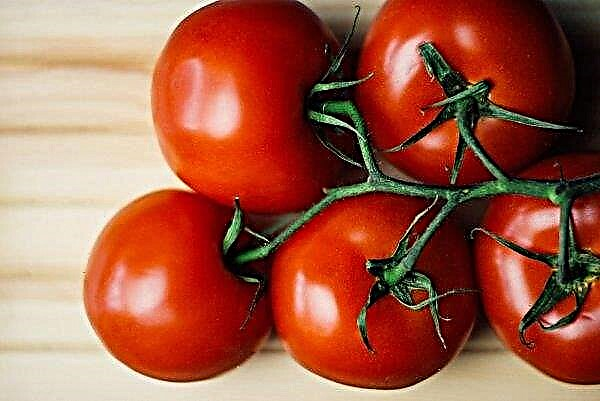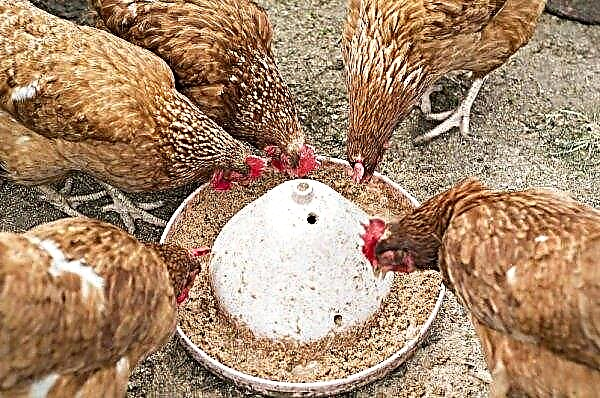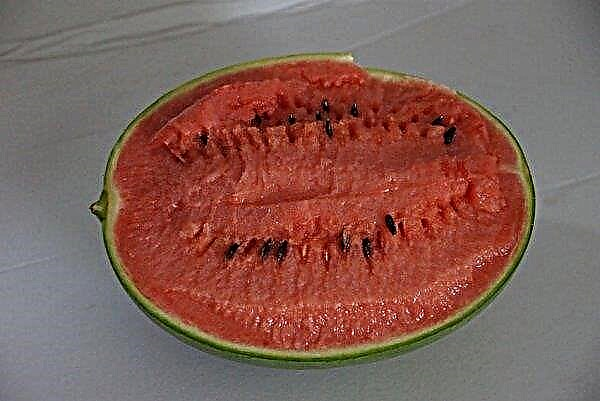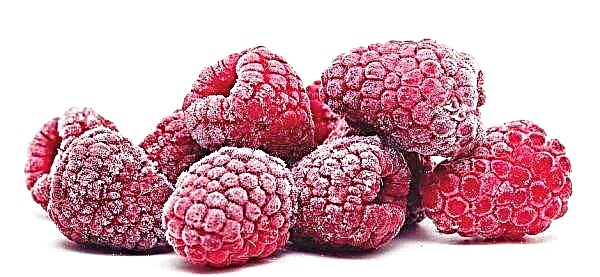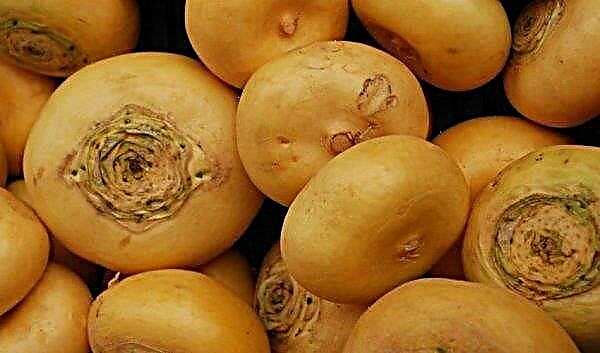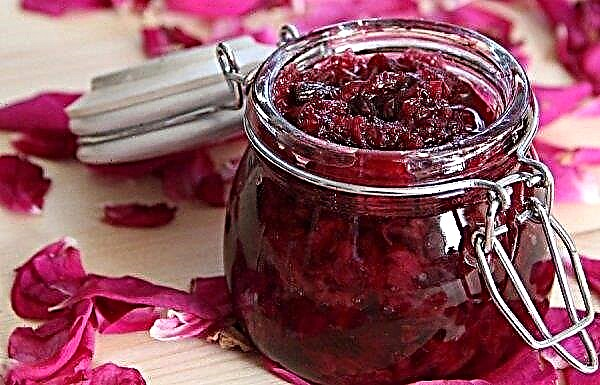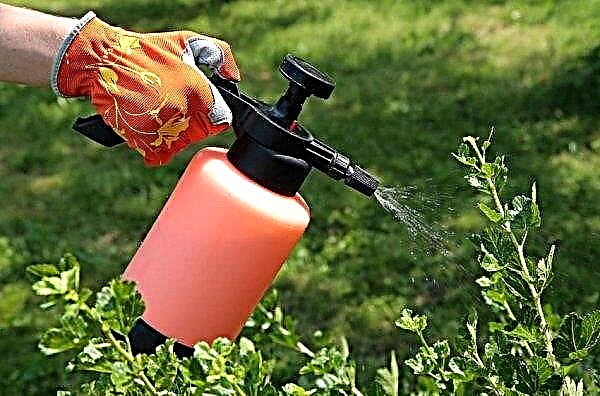Little Red Riding Hood is one of the favorite varieties of beans by farmers and gardeners, characterized by unpretentious care, high productivity and resistance to a number of diseases. The high nutritional and taste qualities of the cooked fruits make the culture also in demand among the culinary and in the canning industry. About how to grow, harvest and preserve the crop of the plant - read the description below.
Description of the variety and its characteristics
Beans Little Red Riding Hood grows in the form of low, up to 35 cm, bushes with spreading branches and yellow-green leaves, blooming white flowers at the time of flowering. In terms of ripening, the variety is a mid-ripening crop, reaching technical (when pods with unripe beans are formed) ripeness 55–65 days after planting, and full fruit ripening within 100 days.
Did you know? In the case of defective formation of the beans, Little Red Riding Hood should not give up the crop and destroy it. The natural properties of the plant allow you to eat even green pods.
Distinctive features
Externally, a variety can be determined by a number of characteristic features:
- grown pod containing from 8 to 12 grains, has a yellowish color and reaches a length of 10-12 cm;
- ripened beans of a slightly curved oval shape differ in slightly flattened sides and an average length of 9 to 11 mm;
- the bivalve grain structure with incomplete internal partitions has a weakly expressed parchment layer;
- The original color of the grains includes a large red spot, covering about a third of the white beans, which is why the variety got its name.

Advantages and disadvantages of the variety
Engaged in the cultivation of Little Red Riding Hood, one can quite reasonably rely on a consistently high yield with indicators up to 3 t / 1 ha, without fear of problems such as lodging bushes or most diseases. However, it is necessary to take into account the thermophilic culture. Beans cannot tolerate freezing, and planting it in a cool climate can lead to incomplete ripening of grains, which, however, does not necessarily mean loss of crop.
Basic rules for planting beans Little Red Riding Hood
Despite the unpretentiousness of this variety, when planting it is recommended to adhere to a number of recommendations for each stage of sowing and cultivation.
Seed preparation
In order to reject low-quality seed material, it is recommended to carefully examine the bean seeds before planting for sagging, rot, dark spots, mold, cracks, etc., simultaneously sorting and removing all the seeds unsuitable for sowing. The rest should be soaked in water for 6-12 hours before being placed in the ground. In case of doubt about the quality of the seeds, they should be pre-sowed: to soak, use not a water, but a warm solution of potassium permanganate or boric acid (if necessary, a solution of fungicides and insecticides), the excess of which is then poured into the soil
In case of doubt about the quality of the seeds, they should be pre-sowed: to soak, use not a water, but a warm solution of potassium permanganate or boric acid (if necessary, a solution of fungicides and insecticides), the excess of which is then poured into the soil
Capacity and soil
It is advisable to plant the Little Red Riding Hood variety in areas with fertile soil with neutral acidity, without stagnation of groundwater. The best option for this is loam - a type of soil with a high content of clay and sand. If the cultivation is planned to be carried out in containers, then often for this purpose a common box or individual pots with a depth of 20 cm or more with drainage holes are chosen.
Did you know? As a guide for the optimal time for Red Riding Hood to plant in open ground, you can use the time of flowering of chestnuts, which is a sign of normal heating of the soil.
The bottom of such containers is covered with a 2-3 cm layer of expanded clay, on top of which soil is laid at the rate of 3-5 liters per plant. You can use universal soil for seedlings of vegetable crops from a store or made up personally of turf soil, humus and wood ash in the proportions of one bucket: 1 part of the earth, 1 part of humus, 1 glass of ash.
Direct sowing
Considering the heat-loving nature of the bean, it should be planted in open ground in May, after the establishment of stable warm weather with air temperature above + 16 ° С and soil warming up to + 12 ° С. At the same time, it is advisable to plant the beans in the beds warmed by the sun and protected from the wind, observing the following recommendations:
- Before planting on future beds, apply a small amount of nitrogen fertilizer, preferably using land from areas where beans were previously grown.
- Sow in moist soil, followed by watering with water settled in the sun.
- Pre-prepare the holes with a depth of 3-5 cm, maintaining a distance of approximately 30 cm between rows.
- Keep a distance of at least 10 cm between grains immersed in the ground.

Beans can be planted in rows, by a nesting method or in a checkerboard pattern, given that the most convenient harvest provides the first option.
Video: planting beans in open ground
Culture Care Features
To obtain a significant harvest of beans, an important factor is the proper care of it during its germination, flowering and fruit ripening. Caring for Little Red Riding Hood is similar to caring for other varieties of beans and includes procedures such as watering, loosening the soil, weeding and top dressing, the description of which is presented in the table below:
| Watering | From the time of planting to the appearance of the first flowers, it is produced no more than 1 time in 7-10 days using water that has settled in the sun. In this case, its quantity depends on weather conditions and soil conditions and is determined by the degree of soil moisture, which should be moderate without getting wet. After the appearance of 4-5 leaves, it completely stops, since excess moisture contributes to the growth of leaves and impairs fruiting. Watering resumes at the time of flowering by increasing the amount of water and reducing the intervals between procedures. With the advent of pods, it increases and doubles with complete cessation several weeks before the harvest. |
| Loosening | It is carried out between waterings in order to loosen hardened soil, with a small blade and at shallow depth so as not to damage the root system of plants. |
| Weeding | It is carried out regularly as weeds grow, capable of inhibiting the growth and development of the crop. |
| Top dressing | It is carried out with the subsequent watering of the soil, since the plants absorb nutrients in dissolved form. For the first time, it is produced in the first leaf phase using superphosphate in an amount of 35–40 g per 1 m², during the budding period - with a solution of potassium salt at the rate of 15 g per 1 m², and during the formation of beans - by sprinkling in the aisles 1 glass of wood ash per running meter. It is recommended to be careful with nitrogen fertilizers due to the ability of the beans to independently accumulate nitrogen on the roots. |
Features of cultivation and possible difficulties
Unlike some other bean varieties, Little Red Riding Hood does not require tying, while also providing a certain saving of land due to the growth of small compact bushes with a stable and high yield. However, when growing it, in no case should you forget about the dependence of the plant on heat.
Important! When planning and conducting irrigation, the amount of possible natural precipitation should be taken into account, adjusting, depending on the state of the soil, their schedule and amount.
In this regard, during early planting, followed by a decrease in temperature and, above all, during return frosts, bean sprouts should be covered with a film. If the planting is carried out in cold regions, it is recommended to carry it out in greenhouses, which are installed approximately 10 days before the planned sowing and removed after the final completion of frosts.
Diseases and Pests
Like many other garden plants, the health of the Little Red Riding Hood beans can be caused by improper care and various types of insects, as well as damage to the soil or seeds by viruses, infections, fungi. And if for some diseases (for example, anthracnose or bacteriosis), beans are resistant or treatable, then it is difficult for her to resist such a viral disease as a mosaic. When this virus is damaged, the metabolism is disturbed, the beans lag behind in growth, lose their productivity and may not yield a crop, while there is no cure for mosaic, like other viral diseases. Of the pests, the main danger to the culture is the bean kernel laying the larvae on the seeds or dry grains, as well as a spider mite that infects a plant in a greenhouse.
When this virus is damaged, the metabolism is disturbed, the beans lag behind in growth, lose their productivity and may not yield a crop, while there is no cure for mosaic, like other viral diseases. Of the pests, the main danger to the culture is the bean kernel laying the larvae on the seeds or dry grains, as well as a spider mite that infects a plant in a greenhouse.
Given the variety of possible diseases, the primary goal in the struggle for the health of beans and crop preservation is prevention, which includes:
- the use of quality seed;
- the cleanliness of the sowing zone;
- crop rotation;
- balanced top dressing.
In case of infection of plants, bio- or chemical preparations should be used, removing painful sprouts when it is impossible to treat them with the obligatory destruction of plant residues, including roots, at the end of each garden season.
Harvesting and storage
Bean fruits begin to ripen approximately 2 weeks after the beginning of flowering, so the first crop can be harvested during this period. Cutting young pods is recommended in the morning, because when they are moistened with dew, they become as juicy as possible and acquire a fragrant taste. Further, their collection continues every 2-3 days. The ripened crop begins to be harvested after the pods turn yellow and dry, picking them up and removing the beans by the peeling method.Then the grains are dried in the sun (in the oven) for 1-3 days and poured for storage in a tightly closed container or in linen bags. Alternatively, the beans can be stored frozen.
The ripened crop begins to be harvested after the pods turn yellow and dry, picking them up and removing the beans by the peeling method.Then the grains are dried in the sun (in the oven) for 1-3 days and poured for storage in a tightly closed container or in linen bags. Alternatively, the beans can be stored frozen.
If beans are grown for grain, then it is recommended to harvest once by cutting and drying the bushes in the form of bunches suspended in a dry and well-ventilated room, followed by peeling and storage in glass containers.
Subject to proper seed selection and care at the sowing place, Little Red Riding Hood beans brings a high yield with low material, technical and time costs for caring for it. And the unusual coloring of the fruits, along with their taste, ensures the wide popularity of the plant among consumers.Important! To prepare the seed for next year, you should choose the first two lowermost ripe pods, which should be stored in the refrigerator after drying and removing the beans.

